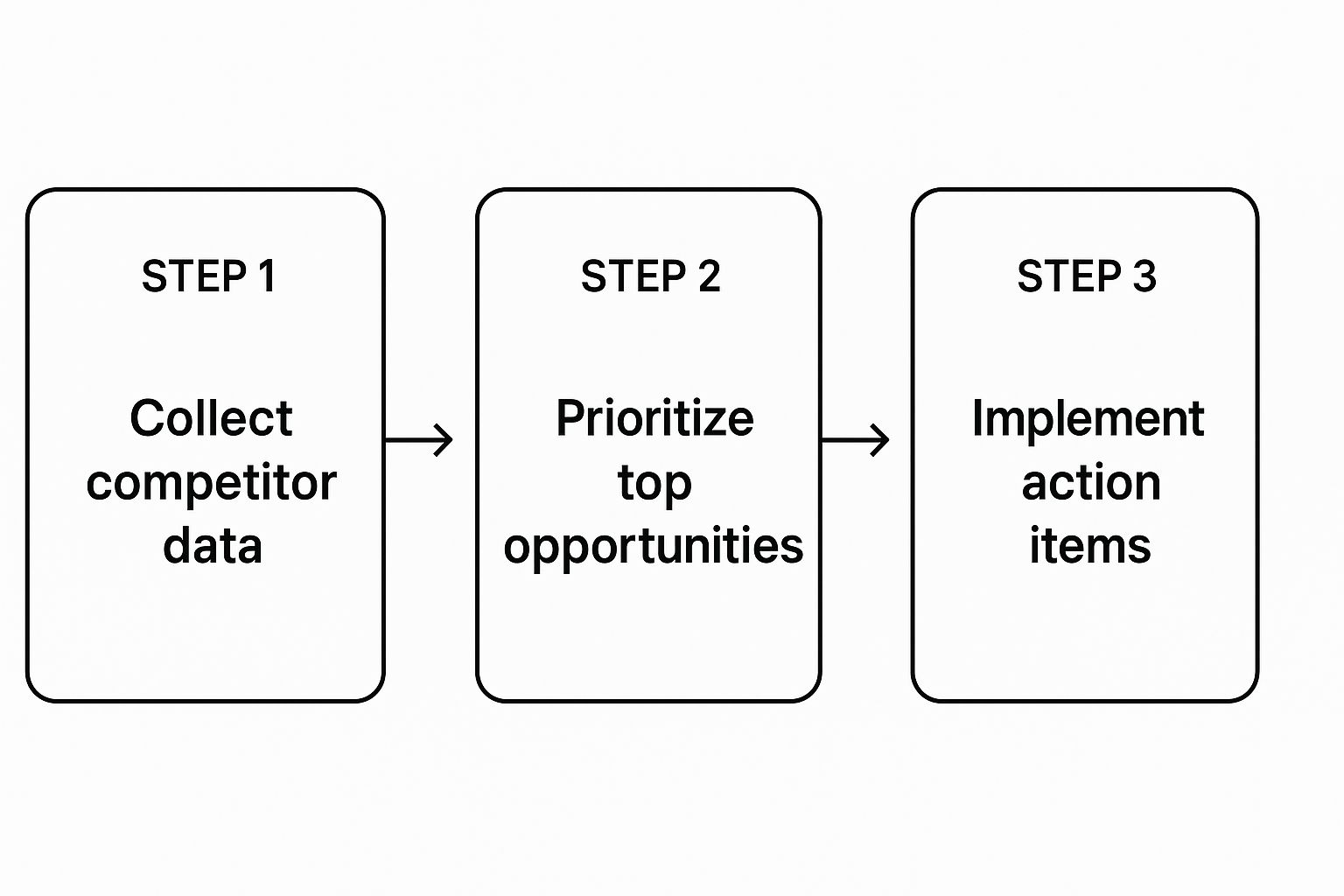
Free Website Competitor Analysis for Restaurant Equipment Suppliers
Share
Have you ever been completely baffled by how a local competitor suddenly shoots to the top of Google for something like 'commercial kitchen ranges'? It often comes down to a smarter digital game plan, not just a fatter wallet. The secret weapon here is a free website competitor analysis, which is your ticket to leveling the playing field without spending a single dime.
Why Competitor Analysis Drives Restaurant Equipment Sales

For a restaurant equipment supplier, having the best charbroilers isn't enough. You need to be found by the chefs and restaurant managers who are actively looking to buy them. Think of a competitor analysis as getting a peek at a rival’s playbook. It lays out their exact online strategy for attracting customers, giving you the intel to build a better one.
This isn't about just copying what everyone else is doing. It's a bit like business intelligence for the digital world. It shines a light on huge opportunities you might be completely missing right now. When you really dig into your competitors' digital footprint, you can start making sharp, informed decisions that have a real impact on your sales.
Pinpoint Actionable Insights
A proper analysis goes way beyond just looking at a competitor's homepage. It should hand you a clear roadmap for growth by answering the tough questions that will shape your entire marketing strategy. For example, what specific search terms are your competitors ranking for that you aren't? Are they making video guides on "how to clean a commercial deep fryer" that are sucking up all the valuable traffic?
By breaking down what they’re doing, you can uncover some real gems:
- Untapped Keywords: Find the exact phrases restaurant owners are typing into Google, whether it's "NSF certified prep tables" or "financing for commercial ice machines."
- Content Gaps: See what topics your competitors are totally ignoring. Maybe they have zero content comparing different convection oven brands—that’s a perfect opening for you to swoop in with professional article writing.
- Digital Strengths and Weaknesses: Get a clear picture of where they're strong and where they're vulnerable. Perhaps their website is painfully slow, or their product descriptions are super thin. Those are weaknesses you can absolutely exploit.
The goal here is simple: learn from their wins and their mistakes to speed up your own growth. This whole process turns vague guesswork into a data-driven plan, giving you a real, tangible edge in a crowded market.
At the end of the day, doing a free website competitor analysis leads directly to more qualified leads, much stronger local search rankings, and a real return on your marketing efforts.
Pinpointing Your Actual Online Competitors
Your biggest rival might not be the showroom down the street. It’s easy to think that way, but in the digital space, you could be fighting for attention with a massive national supplier, an influential restaurant equipment review blog, or even a local directory that dominates Google.
The first real step in any useful free website competitor analysis is figuring out who you’re actually up against online.
This whole process starts with one simple question: how does your customer think? A restaurant owner who needs a new walk-in cooler isn't just typing "restaurant equipment" into Google. They’re using specific, high-intent phrases that tell you they're getting ready to pull out their credit card.
Discovering Your Digital Rivals
Jump over to Google and run a few simple searches for the kind of valuable terms your ideal customers would actually use. And don't just glance at who shows up on page one; pay close attention to the types of sites that consistently appear.
Here are a few examples to get you started:
- "Restaurant walk-in cooler financing"
- "Best commercial deep fryer reviews"
- "Used commercial kitchen supply Boston"
- "How to maintain a commercial ice machine"
Jot down the top 3-5 domains that keep popping up for these kinds of queries. This quick exercise will immediately show you who is grabbing your audience's attention when it matters most.
To really nail down who your online competitors are and see how you stack up, you need to understand your brand's share of voice in the market. This metric shows you exactly how visible your brand is for key search terms compared to everyone else, giving you a clear picture of who’s winning the online conversation.
Categorizing the Competition
Once you have a list of domains, it's time to sort them out. This is a crucial step because it helps you understand who you're dealing with and build a smarter strategy. After all, not everyone ranking for your keywords is trying to sell the same charbroiler you are.
You'll quickly notice they fall into two main buckets:
Direct Competitors
These are the obvious ones. They sell the same or very similar restaurant equipment to the same people you do. Think of another local supplier or a big e-commerce store that specializes in commercial kitchen gear.
Indirect Competitors
These are the trickier ones. They aren't selling the same products, but they are absolutely siphoning off valuable traffic from your potential customers. This could be a popular food industry blog with "Top 10 Commercial Ovens" articles or a local business directory. They’re competing for eyeballs and authority, not a direct sale.
By the end of this discovery phase, you should have a focused list of 3-5 key players—a mix of direct and indirect competitors. This keeps your analysis targeted, manageable, and a whole lot more impactful.
Uncovering Competitor SEO & Keyword Strategies

Alright, you've got your list of competitors. Now for the fun part: pulling back the curtain on their SEO strategy. This is where a free website competitor analysis gets really interesting, because you're about to discover the exact search terms that are sending paying customers right to their digital doorstep.
Don't worry, you won't need any expensive, complicated software for this. With a few free tools and a bit of detective work, you can figure out which keywords form the backbone of their online presence. This process essentially hands you a proven list of topics to target with your own blog posting and copywriting.
Using Free Tools to Find Competitor Keywords
The easiest place to start is with a tool like Google Keyword Planner. It’s built for advertisers, but it’s a goldmine for organic research. You can pop a competitor's URL right into the tool and see the keywords Google thinks their site is all about.
Let's say you plug in a rival's domain and find out they’re ranking high for "eco-friendly commercial dishwashers." That’s a huge insight. It tells you there's a specific group of buyers looking for sustainable kitchen gear—a niche you can now target with your own product pages or blog posts.
Another killer technique is what's known as a keyword gap analysis. It's just a fancy way of saying you're looking for valuable keywords your competitors rank for, but you don’t. Think of it as finding a treasure map they've already done the hard work of drawing for you.
It's simple: every keyword they rank for is a potential customer you're missing out on. Finding these gaps gives you a direct, actionable list of content you need to create to start winning that traffic.
Modern marketing tools are essential for a good competitor analysis, offering deep dives into a rival's traffic and content. The marketing tech industry is exploding, projected to grow from $47.32 billion in 2025 to $107.5 billion by 2028, largely thanks to AI. Companies that use these platforms can see traffic boosts of up to 20% and ranking improvements around 30%, proving how powerful data-driven insights can be. You can learn more about how AI is shaping competitive research on superagi.com.
Putting Keyword Insights into Action
Once you have this keyword list, you can start strategically going after these terms. But don't just stuff them onto your website. The goal is to create genuinely helpful content that actually solves a restaurant owner's problem.
Here’s how you can put your findings to work:
- Product Pages: Did you find out they rank for "heavy-duty gas charbroilers"? Go look at your own charbroiler pages. Make sure they're fully optimized with professional copywriting.
- Blog Posts: If a competitor is getting traffic from a post titled "how to choose a commercial convection oven," your job is to write a guide that's even more thorough and helpful.
- Local Service Descriptions: Did you uncover local keywords like "restaurant equipment repair in Austin"? Weave those terms naturally into your pages with smart SEO to grab nearby customers.
This whole process gives you a content strategy that’s built on proven demand. You're no longer guessing what your customers are searching for—you're using your competitor's success as a blueprint.
Of course, once you start targeting these new keywords, you've got to track your progress. To get a handle on that, check out our guide on how to track keyword rankings to measure your success the right way.
Digging Into Your Competitor's Content Playbook
A website that pulls in serious traffic is always built on a foundation of great content. To do a real free website competitor analysis, you have to put on your content strategist hat and take a hard look at what your rivals are publishing. This is where we move past keywords and get to the heart of what builds trust and actually drives sales.
You need to break down their content from the perspective of a busy restaurant owner. What materials are they creating that genuinely solve a problem or help someone make a smarter purchase? This isn't just about blog posts; it's their entire content ecosystem.

What Makes Their Content Good (Or Bad)?
Start by just browsing their website with a critical eye. A simple mental checklist can help you size up their approach and spot where they’re winning or, more importantly, where they're dropping the ball. Look for stuff that speaks directly to a commercial kitchen audience—think detailed guides on maintaining a commercial oven or comparison articles between different ice machine brands.
Ask yourself a few key questions as you poke around:
- Are the product descriptions actually helpful? Do they just list specs, or does their copywriting explain why a certain charbroiler is perfect for a high-volume diner versus a small bistro?
- What about visuals? Are they using high-quality videos that show the equipment in action? Or is it just a wall of static, low-res images? That's a huge weakness you can exploit.
- Is their content solving real problems? Look for articles, guides, or FAQs that tackle common customer headaches, like installation nightmares or cleaning best practices.
- Can people even find anything? A confusing site or a clunky checkout process is a dead end. It creates friction and sends potential customers running to a competitor—maybe you.
By analyzing their content wins and failures, you can pinpoint exactly where to invest your efforts. If their blog is a ghost town or their product pages are thin, you have a clear opportunity to create a superior experience that builds authority and guides customers more effectively.
Finding the Gaps in Their Strategy
Once you have a feel for their quality, it’s time to hunt for the gaps. This is where you find those underserved topics that your customers are searching for. Maybe no one in your space has created a definitive guide to choosing the right size walk-in cooler, or a detailed ROI calculator for investing in a high-efficiency deep fryer.
These gaps are your golden ticket. They represent a chance to become the go-to resource for that specific topic.
When you create in-depth content that fills these voids, you're not just attracting organic traffic—you're positioning your brand as a helpful expert. With professional article writing, you stop being just a seller; you start building a relationship with a potential customer long before they're ready to buy.
If you want to dive deeper into crafting articles that actually rank and connect with readers, check out our guide on how to write SEO-friendly blog posts.
By systematically picking apart their content playbook, you stop simply competing and start strategically outmaneuvering them. You'll be able to address customer needs more thoroughly, answer their questions more clearly, and ultimately build a more trusted and profitable online presence.
Evaluating Backlinks and Digital Authority
Think of backlinks as votes of confidence from other websites. When a reputable site links to your competitor, Google takes that as a strong signal that the competitor is a credible authority.
This digital authority is a massive factor in why some sites outrank others, and digging into it is a crucial part of any free website competitor analysis.
Uncovering who is linking to your competition is like getting a backstage pass to their PR and marketing strategy. Each backlink tells a story. Are they buddying up with influential food bloggers? Getting listed in every local business directory? Or are they being featured in major restaurant trade magazines?
This isn't just interesting trivia—it's a literal roadmap for your own blogger outreach efforts.
Identifying High-Quality Backlink Sources
Let's be clear: not all links are created equal. A single link from a respected national restaurant association is worth more than a hundred links from sketchy, low-quality directories. Your job is to figure out what types of sites are giving your competitors their most powerful endorsements.
Using a free backlink checker, you can plug in a competitor’s URL and see a list of every site linking to them. As you sift through this list, start looking for patterns.
- Industry Publications: Are they getting shout-outs in places like Restaurant Business or Foodservice Equipment & Supplies? This means they're seen as an industry leader.
- Local Directories and News: Look for links from the local Chamber of Commerce, city business journals, or neighborhood news sites. Our local citation services can help you secure these.
- Food and Chef Blogs: A popular chef reviewing a piece of their equipment is a huge vote of confidence that builds trust with your ideal customers.
- Supplier and Manufacturer Sites: Do equipment manufacturers link back to them as an official dealer? These are highly relevant, powerful links.
By seeing where your competitors are earning their authority, you can create a hit list of websites to connect with. This turns link building from a random guessing game into a focused, strategic mission.
This whole process is fundamental to making your website stronger. To really dive deep into this idea, check out our guide on how to build domain authority for your own site.
Turning Analysis into an Outreach Plan
Once you've mapped out the high-value sites linking to your competitors, the real work begins. You need to figure out why they got that link in the first place.
Ask yourself: Did my rival publish an amazing, in-depth guide? Were they featured in an interview? Did they sponsor a local food festival?
Understanding the "why" behind their best links is the key to replicating their success. You can create an even better, more comprehensive guide. You can pitch the same publications with a fresh story angle using targeted blogger outreach. You can get more involved in your local restaurant community.
This is how you systematically build a stronger online reputation, proving your own expertise in the competitive restaurant supply industry.
Turning Your Analysis Into an Action Plan
All that digging around on competitor sites is pointless if you don't do something with what you found. This is where we take all those notes and observations from your free website competitor analysis and shape them into a real, honest-to-goodness to-do list for growing your business.
The goal here isn’t to create some massive, overwhelming report that just collects dust. We want a straightforward, prioritized list of things you can actually get done.
A simple way to get started is to just draw three columns on a piece of paper or in a spreadsheet: Competitor Strengths, Competitor Weaknesses, and Your Opportunities. This layout makes it easy to see the connections. Maybe your rival's strength is their weekly blog posting, but you noticed their website is painfully slow to load—that's a weakness for them and an opportunity for you.
From Insights To Action Items
Now, it's time to translate those "opportunities" into actual tasks. As you put this all together, it's really helpful to know the right way of approaching building a powerful SEO competitive analysis report that can guide your whole strategy. This keeps your plan logical and makes sure no great ideas get lost in the shuffle.
Your final list should feel like a clear road map, not a mountain of work you can't possibly climb. Be realistic and prioritize based on what will give you the most bang for your buck.
A great action plan has a mix of quick wins you can knock out now and bigger goals to work toward. It takes the guesswork out of the equation and tells you exactly what to do next to start pulling ahead of the competition.
For a restaurant equipment supplier, a short, prioritized action plan might look something like this:
- Priority 1: Launch a blog posting schedule targeting keyword gaps like "commercial refrigerator maintenance checklist" to start grabbing search traffic.
- Priority 2: Use expert copywriting to update our top 5 product pages for charbroilers, adding more detailed, helpful descriptions and better photos.
- Priority 3: Use the competitor's backlink list to create a blogger outreach campaign. Pick three local food bloggers and see if they're open to working together.
Your Top Questions Answered
Still have a few things you're wondering about after diving into competitor analysis? Let's clear up some of the most common questions I get from restaurant equipment suppliers.
How Often Should I Be Doing This?
For a full, deep-dive analysis, I recommend doing this quarterly. That’s enough time for market shifts to happen but not so long that you fall behind.
Beyond that, a quick monthly check-in on new content and keyword rankings is a great habit. It helps you react fast to new trends your competitors are jumping on. In the fast-moving restaurant world, staying current is everything.
What's the Single Most Important Thing to Track?
If I had to pick just one, it's the keyword gap.
Finding relevant, high-intent keywords your competitors rank for—but you don't—is like being handed a treasure map. It gives you a direct, actionable roadmap for what content to create next to attract qualified buyers who are ready to pull out their credit cards.
Is It Even Possible to Compete Against the Huge National Suppliers?
Absolutely. It might feel like a David vs. Goliath situation, but you have a secret weapon: local SEO.
While the big chains are busy with their massive budgets, they often completely overlook the local angle. You can win by zeroing in on location-specific keywords (think 'commercial kitchen supply Boston' instead of just 'commercial kitchen supply'). Focus on building local citations and creating content that speaks directly to the unique challenges of restaurants in your region.
This simple visual breaks down how to turn all that data you've gathered into real action.

As you can see, it’s all about a clear three-stage process. You move from collecting the data, to prioritizing what matters, and finally, to implementing specific tasks that will actually grow your business.
Here at Charbroilers.com, we know that having the right equipment is just one piece of the puzzle. That's why we're committed to offering top-tier commercial charbroilers designed to give you a serious competitive edge in the kitchen. Explore our collection of countertop, modular, and floor model charbroilers to find the perfect fit for your restaurant today.
